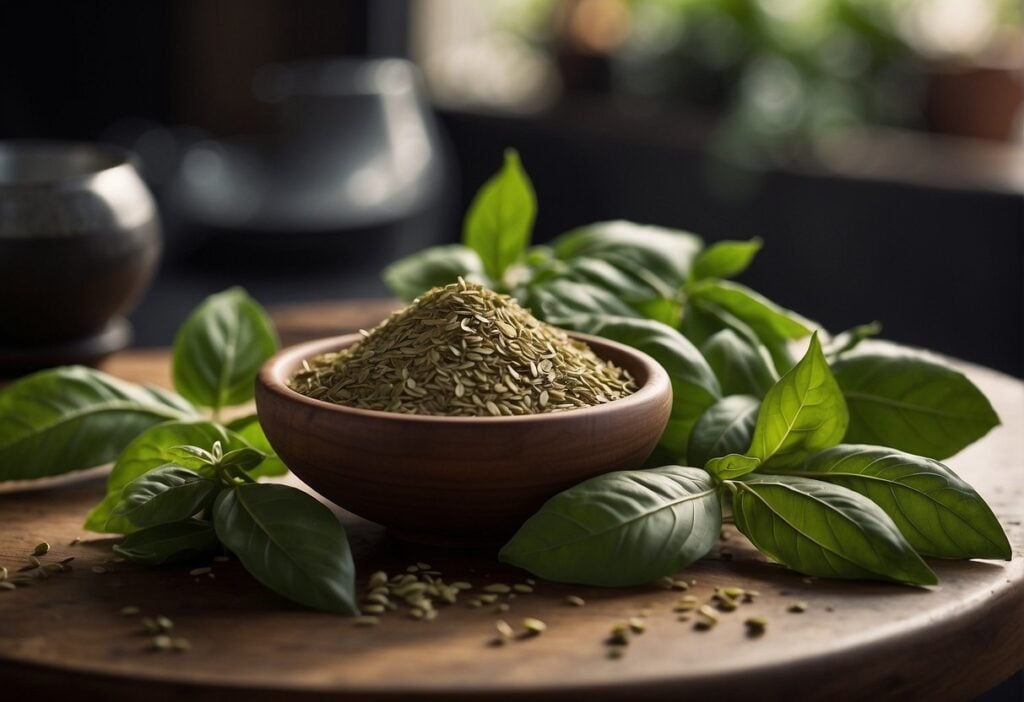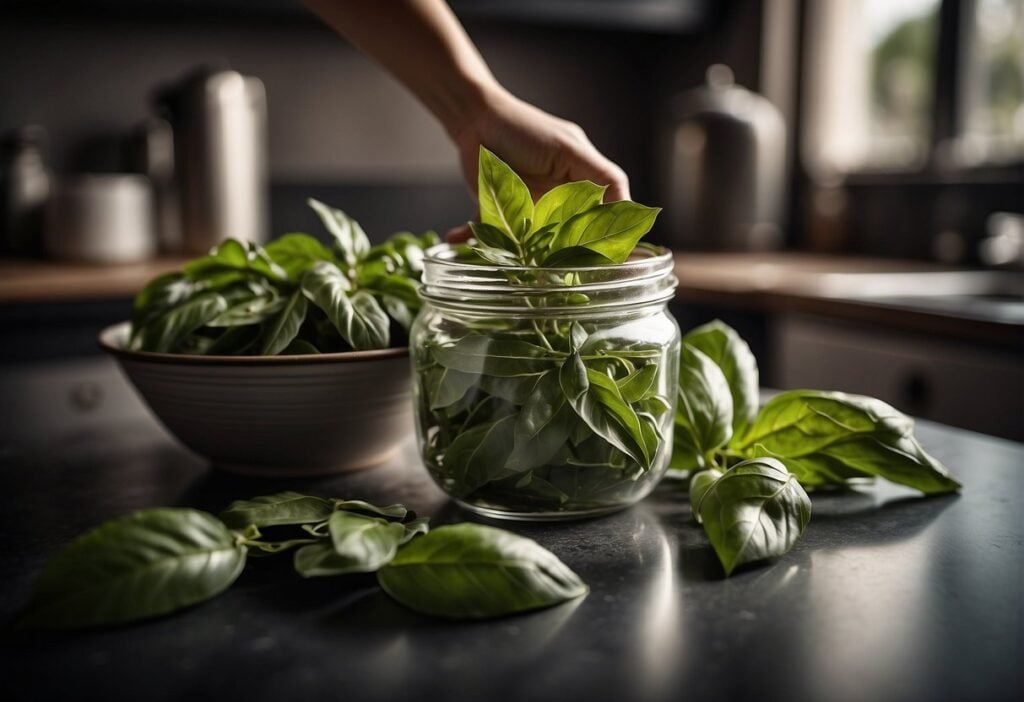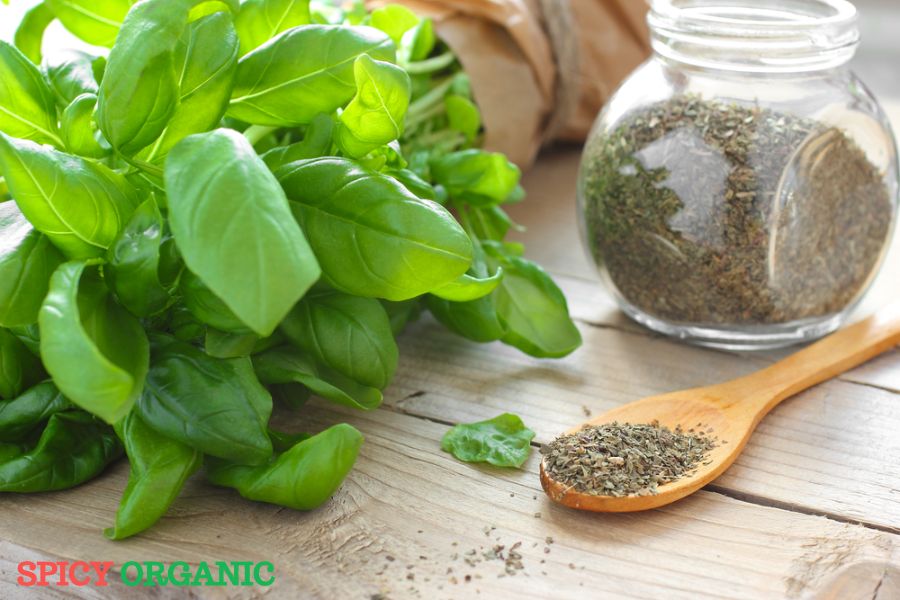Overview Of Basil And Bay Leaf

Basil and bay leaf are both popular herbs used in cooking that offer distinct flavors to various dishes. Basil is known for its sweet, slightly peppery taste with hints of clove and anise. It is widely used in Italian, Mediterranean, and Asian cuisines, adding freshness and depth to dishes like pasta sauces, pesto, and salads. On the other hand, bay leaf provides a subtle earthy flavor with a slight bitterness. It is commonly used to enhance the flavors of soups, stews, and sauces. Both herbs have their unique characteristics and are essential ingredients in many culinary traditions.
1 Basil Characteristics And Uses
Basil is a versatile herb with distinct characteristics and a prominent role in various cuisines. It is known for its sweet and slightly peppery taste with hints of clove and anise, which adds a refreshing and aromatic flavor to dishes. Basil leaves are typically bright green and have a smooth, glossy texture. This herb is widely used in Italian, Mediterranean, and Asian cuisines for its ability to elevate the flavors of pasta sauces, pesto, salads, and even desserts. It also pairs well with tomatoes, cheese, garlic, and other herbs like oregano and thyme.
2 Bay Leaf Flavor Profile And Culinary Applications
Bay leaves have a unique flavor profile and are widely used in culinary applications. They have a subtle, earthy taste with a hint of bitterness and a slightly floral aroma. Bay leaves are often used as a seasoning in soups, stews, and sauces, where they add depth and complexity to the dish. They are also a key ingredient in classic dishes like bouillabaisse and goulash. Additionally, bay leaves are commonly used in pickling brines and are an essential component of the traditional French herb blend, bouquet garni. Their versatility and distinctive flavor make bay leaves a valuable addition to many recipes.
Taste Profile Comparison

When comparing the taste profiles of basil and bay leaf, some distinct differences emerge. Bay leaves offer a subtle, earthy flavor with a hint of bitterness and a slightly floral aroma. On the other hand, basil delivers a vibrant and herbaceous taste with a sweet, slightly peppery flavor and notes of clove and anise. While bay leaves are often used to add depth to soups, stews, and sauces, basil is a versatile herb that complements Italian, Mediterranean, and Asian cuisines. Both herbs bring unique flavors to dishes, enhancing the overall taste experience.
1 Contrasting Flavors Of Basil And Bay Leaf
When it comes to taste, basil and bay leaf offer contrasting flavors. Basil delivers a vibrant and herbaceous taste, with a sweet, slightly peppery flavor and notes of clove and anise. In contrast, bay leaves provide a subtle, earthy flavor with a hint of bitterness and a slightly floral aroma. While basil adds freshness and brightness to dishes, bay leaves contribute a depth and complexity. These distinct flavors of basil and bay leaf allow for a diverse range of culinary creations, adding unique and complementary tastes to various dishes.
2 Impact On Different Dishes
Basil and bay leaf have distinct impacts on different dishes. Basil adds a fresh and vibrant flavor to dishes, making it a popular ingredient in Italian cuisine, particularly in pasta sauces, pesto, and Caprese salad. It also pairs well with tomatoes, mozzarella, and other Mediterranean ingredients. On the other hand, bay leaves contribute a subtle depth and complexity to soups, stews, and sauces, enhancing their flavors over time. They are commonly used in dishes like beef stew, tomato-based sauces, and braised meats, providing a unique and aromatic element. Incorporating basil and bay leaf into various dishes allows for a diverse and flavorful culinary experience.
Health Benefits

Both basil and bay leaf offer various health benefits. Basil is rich in antioxidants, vitamins A and K, and minerals like potassium and calcium. It has anti-inflammatory properties and may help improve digestion, reduce stress, and support cardiovascular health. On the other hand, bay leaf is known for its antimicrobial and anti-inflammatory properties. It may aid in digestion, promote respiratory health, and have potential benefits for blood sugar control. Incorporating these herbs into your diet can provide these health advantages along with their flavorful qualities.
1 Nutritional Value Of Basil
Basil is not only a flavorful herb but also packed with nutritional benefits. It is low in calories and offers a good amount of vitamins and minerals. Basil is a rich source of vitamin K, which plays a crucial role in blood clotting and bone health. It also contains significant amounts of vitamin A, promoting healthy vision and radiant skin. Additionally, basil provides manganese, a mineral involved in various enzymatic processes. Incorporating basil into your diet can be a great way to enjoy its delicious taste while reaping its nutritional advantages.
2 Health Advantages Of Consuming Bay Leaf
Bay leaf not only enhances the flavor of dishes, but it also offers several health benefits. Consuming bay leaf can aid in digestion as it contains enzymes that help break down food and promote better absorption of nutrients. Additionally, bay leaf is known for its anti-inflammatory properties, which can help alleviate symptoms of arthritis and reduce inflammation in the body. The antioxidants present in bay leaf can also contribute to overall heart health by reducing the risk of cardiovascular diseases. Incorporating bay leaf into your meals can be a simple and flavorful way to enjoy these health advantages.
Cooking Tips

When cooking with basil, it is best to add it towards the end of the cooking process to preserve its vibrant flavor and aroma. Basil can be torn or chopped and added to salads, sauces, or used as a garnish for pizzas and pasta dishes. Basil leaves can also be made into pesto, which is a versatile sauce that can be used as a spread or combined with pasta. On the other hand, bay leaves are typically used as a flavor enhancer in long-simmered dishes such as soups, stews, and braises. Remember to remove the bay leaves before serving, as they are not meant to be eaten. Using these cooking tips will help you make the most of the unique flavors of both basil and bay leaf in your culinary creations.
1 Pairing Basil With Specific Dishes
Basil is a versatile herb that pairs well with a variety of dishes. Its herbaceous and slightly sweet flavor can enhance the taste of many foods. Here are some specific dishes that benefit from the addition of basil:
- Italian dishes: Basil is a staple in Italian cuisine and is commonly used in pasta sauces, bruschetta, and Caprese salad. Its fresh aroma and bright taste complement the flavors of tomatoes, garlic, and mozzarella.
- Thai cuisine: Basil is essential in Thai cooking, particularly in dishes like green curry and pad Thai. Its distinct flavor adds depth and freshness to the spicy and savory flavors of these dishes.
- Mediterranean dishes: Basil is a key ingredient in Mediterranean cuisine. It can be used in dishes such as Greek salad, pesto sauce, and grilled vegetables to add a burst of flavor.
- Soups and stews: Basil can be added to soups and stews towards the end of cooking to provide a fragrant and aromatic finish. It pairs well with tomato-based soups, vegetable soups, and even hearty meat stews.
By incorporating basil into these specific dishes, you can elevate the taste and bring out the best flavors in each recipe.
2 Enhancing Flavors With Bay Leaf In Cooking
Bay leaf is a versatile herb that can enhance the flavors of various dishes when used properly. Its subtle yet distinct flavor adds depth and complexity to soups, stews, and sauces. Bay leaf is often used in long-cooking dishes, as it releases its aromatic and slightly sweet flavor over time. To maximize the flavor, it is recommended to use whole bay leaves and remove them before serving. Bay leaf pairs well with ingredients such as onions, garlic, tomatoes, and meats like beef and poultry. Adding bay leaf to your cooking can elevate the taste and bring a unique dimension to your dishes.
Common Culinary Uses

Basil and bay leaf have common culinary uses in various cuisines. Basil is widely used in Italian cooking and is a key ingredient in dishes such as caprese salad, pesto sauce, and pasta sauces. It pairs well with tomatoes, garlic, and mozzarella cheese. On the other hand, bay leaf is commonly used in soups, stews, and braised meats to add a subtle and aromatic flavor. It is often found in Mediterranean, Indian, and Middle Eastern cuisines. Both herbs can also be used to infuse flavor into oils, vinegars, and marinades.
1 Basil In Italian Cuisine
Basil holds a prominent place in Italian cuisine, adding a touch of freshness and flavor to various dishes. It is a key ingredient in classics such as caprese salad, where it complements the sweetness of tomatoes and the creaminess of mozzarella cheese. Basil is also widely used in pasta sauces, bringing a vibrant, aromatic element to the dish. Its versatile nature allows it to pair well with other Italian ingredients like garlic, olive oil, and balsamic vinegar. Incorporating basil into Italian dishes enhances the overall taste and adds an authentic Italian flair.
2 Bay Leaf In International Dishes
Bay leaf is not only popular in Mediterranean and Indian cuisines, but it also plays a significant role in international dishes. In French cuisine, it is a key ingredient in bouquet garni, a herb mixture used to enhance the flavors of soups, stews, and stocks. In Mexican cuisine, it is used in dishes like mole and adobo for its distinct aroma and flavor. Bay leaf is also commonly used in Middle Eastern and North African cuisine, where it adds depth to dishes like tagines and biryanis. Its versatility and unique flavor make it a staple in various international cuisines.
Conclusion

In conclusion, the comparison between basil and bay leaf highlights their distinct flavor profiles and culinary applications. While basil offers a vibrant and herbaceous taste, bay leaf provides a subtle earthiness with a slightly bitter undertone. Both herbs have their unique roles in enhancing the flavors of various dishes. Whether you are preparing Italian cuisine with basil or adding depth to soups and stews with bay leaf, understanding their differences allows for more effective ingredient selection. Experimenting with these herbs in your cooking will open up a world of flavors and elevate your culinary creations.
Comparison Of Basil And Bay Leaf Characteristics
When comparing basil and bay leaf, it is important to note their distinct characteristics. Basil is known for its bright green leaves and a distinct aroma reminiscent of cloves and anise. It has a sweet and slightly peppery taste that adds freshness and depth to dishes. Bay leaf, on the other hand, has darker green leaves with a leathery texture and a more subtle aroma. Its flavor is earthy and slightly bitter, making it ideal for imparting a complex, deep flavor to soups, stews, and sauces. Both herbs have unique qualities that enhance the flavors of various dishes, allowing for diverse culinary applications.
Recommendations For Herb Usage And Flavor Pairings
When it comes to using basil and bay leaf in your dishes, there are a few recommendations for herb usage and flavor pairings.
- Basil: Use basil in Italian cuisine such as pasta dishes, pizza, and tomato-based sauces. It also pairs well with lemon and citrus flavors, making it a great addition to salads and dressings.
- Bay Leaf: Bay leaf is commonly used in slow-cooked dishes like soups, stews, and braised meats. It adds depth and complexity to rich flavors. It also pairs well with spices like cinnamon, cloves, and allspice.
By incorporating these herbs in the right dishes and flavor combinations, you can enhance the taste and aroma of your culinary creations.
FAQ About Basil Vs Bay Leaf: Contrasting Herb Flavors
Q: What is the main difference between basil and bay leaf in terms of flavor?
A: Basil has a sweet and slightly peppery flavor with a hint of clove, while bay leaf offers a more subtle and earthy taste with a menthol undertone.
Q: Can basil and bay leaf be used interchangeably in recipes?
A: No, basil and bay leaf have distinct flavor profiles that are not interchangeable. Basil is typically used fresh in dishes like salads, pasta, and pesto, while bay leaf is used dried in soups, stews, and sauces to impart a rich depth of flavor.
Q: Are there any health benefits associated with basil and bay leaf?
A: Yes, both basil and bay leaf are rich in antioxidants and have anti-inflammatory properties. Basil is also known for its antibacterial and anti-cancer effects, while bay leaf is believed to aid digestion and regulate blood sugar levels.
Q: How should basil and bay leaf be stored to maintain freshness?
A: Fresh basil should be stored in a glass of water on the countertop or in the refrigerator wrapped in a damp paper towel. Dried bay leaves should be kept in an airtight container away from heat and light to preserve their aroma and flavor.
Q: Can basil and bay leaf be grown at home?
A: Yes, both basil and bay leaf can be grown indoors or outdoors with proper care. Basil thrives in warm, sunny conditions with regular watering, while bay leaf prefers well-draining soil and moderate watering. It is recommended to harvest basil frequently to promote new growth and prune bay leaf to maintain its shape and vigor.

Hot Pot Chinese Restaurant, located in Mechanicsville, MD 20659, is a culinary destination that offers a delightful array of Chinese cuisine. From the cozy ambiance to the delectable dishes, Hot Pot Chinese Restaurant is dedicated to providing an exceptional dining experience for all patrons. Since our establishment, Hot Pot Chinese Restaurant has been committed to serving the finest Chinese food, offering a diverse menu that caters to a wide range of tastes. Whether you’re craving traditional favorites like Kung Pao Chicken and Mongolian Beef or seeking out more adventurous options like Szechuan Spicy Hot Pot, our menu has something to satisfy every craving.